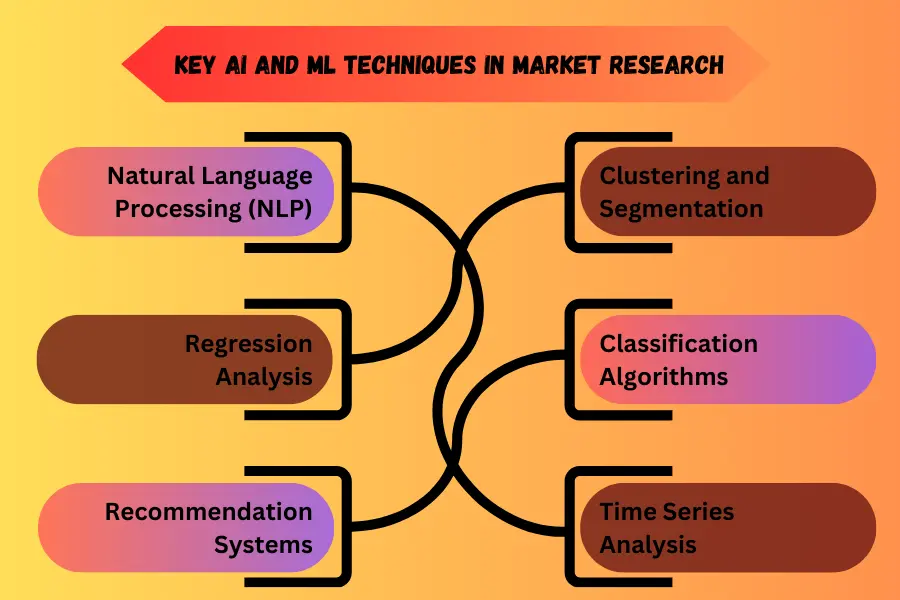AI and ML Algorithms: Analysing Data for Market Research Insights
In the contemporary business landscape, making informed decisions is paramount. Artificial Intelligence (AI) and Machine Learning (ML) have revolutionised market research by providing powerful tools to analyse vast amounts of data, uncover patterns, and generate actionable insights. This article explores how AI and ML algorithms enhance market research, detailing the methodologies and benefits involved.

The Role of AI and ML in Market Research
AI and ML algorithms excel at processing large datasets with high speed and accuracy, far beyond human capabilities. They can identify trends, predict outcomes, and offer deeper insights into consumer behaviour and market dynamics. This enables businesses to make data-driven decisions that are more precise and timely.
Key AI and ML Techniques in Market Research
Several AI and ML techniques are particularly valuable for market research
- Natural Language Processing (NLP): NLP algorithms analyze textual data from sources such as social media, customer reviews, and survey responses. They can perform sentiment analysis, topic modeling, and keyword extraction to understand public opinion and emerging trends.
- Clustering and Segmentation: ML algorithms like k-means clustering and hierarchical clustering group similar data points together. This technique is useful for market segmentation, allowing businesses to identify distinct customer groups and tailor their strategies accordingly.
- Regression Analysis: Linear and logistic regression models help in understanding the relationships between variables. For example, they can predict how changes in price or advertising spend might impact sales.
- Classification Algorithms: Techniques such as decision trees, random forests, and support vector machines (SVM) classify data into predefined categories. These are useful for predicting customer churn, classifying customer feedback, and more.
- Recommendation Systems: Using collaborative filtering and content-based filtering, ML algorithms can provide personalized product recommendations to users, enhancing customer satisfaction and increasing sales.
- Time Series Analysis: Algorithms like ARIMA and Long Short-Term Memory (LSTM) networks are used to forecast future trends based on historical data. This is particularly useful for demand forecasting and inventory management.
Benefits of AI and ML in Market Research
- Enhanced Accuracy and Efficiency: AI and ML algorithms can process and analyze vast datasets quickly and accurately, reducing human error and enabling faster decision-making.
- Deep Insights: These technologies can uncover hidden patterns and correlations in data that might be missed by traditional analysis methods. This leads to more profound insights into market trends and consumer behavior.
- Personalization: By analyzing individual customer data, businesses can offer personalized experiences, which can significantly improve customer satisfaction and loyalty.
- Predictive Analytics: AI and ML can predict future trends and behaviors, allowing businesses to proactively address potential challenges and capitalize on emerging opportunities.
- Cost Reduction: Automating data analysis with AI and ML reduces the need for extensive manual labor, lowering operational costs and freeing up resources for other critical tasks.
Practical Applications in Market Research
AI and ML are applied in various market research scenarios
- Customer Feedback Analysis: NLP algorithms analyze customer feedback from multiple channels to gauge satisfaction levels and identify areas for improvement.
- Market Segmentation: Clustering algorithms segment the market into distinct groups based on demographics, purchasing behavior, and preferences, enabling targeted marketing strategies.
- Trend Prediction: Time series analysis forecasts market trends, helping businesses anticipate demand and adjust their strategies accordingly.
- Product Development: ML models analyze consumer data to identify gaps in the market and suggest new product features or entirely new products that meet customer needs.
- Competitive Analysis: AI algorithms monitor competitors' activities and market movements, providing insights into their strategies and performance.
Challenges and Considerations
Despite the advantages, implementing AI and ML in market research comes with challenges. Data quality and availability are crucial; poor data can lead to inaccurate predictions. Moreover, there is a need for skilled professionals to develop, interpret, and maintain these models. Ethical considerations, such as data privacy and bias in algorithms, must also be addressed to ensure fair and responsible use of AI and ML.
Active Events
Navigating the World of SERP Features: Tips, Tricks, and Strategies
Date: Aug 07, 2025 | 7:00 PM(IST)
7:00 PM(IST) - 8:10 PM(IST)
2811 people have registered
Best Tips to Create a Job-Ready Data Science Portfolio
Date: Aug 06, 2025 | 7:00 PM(IST)
7:00 PM(IST) - 8:10 PM(IST)
2811 people have registered
Bootcamps
Data Science Bootcamp
- Duration:4 Months
- Start Date:Aug 09, 2025
Full Stack Software Development Bootcamp
- Duration:4 Months
- Start Date:Aug 09, 2025
